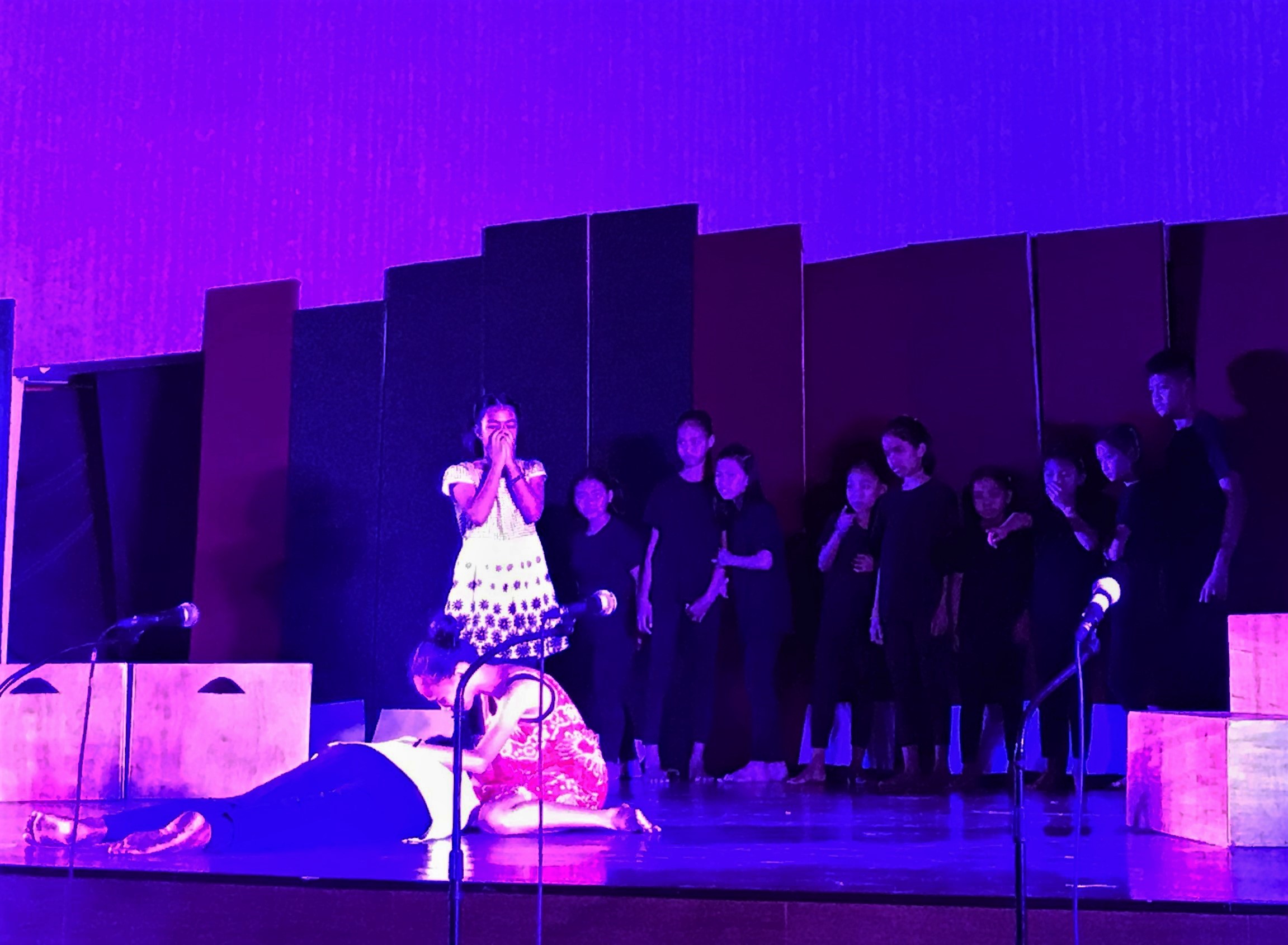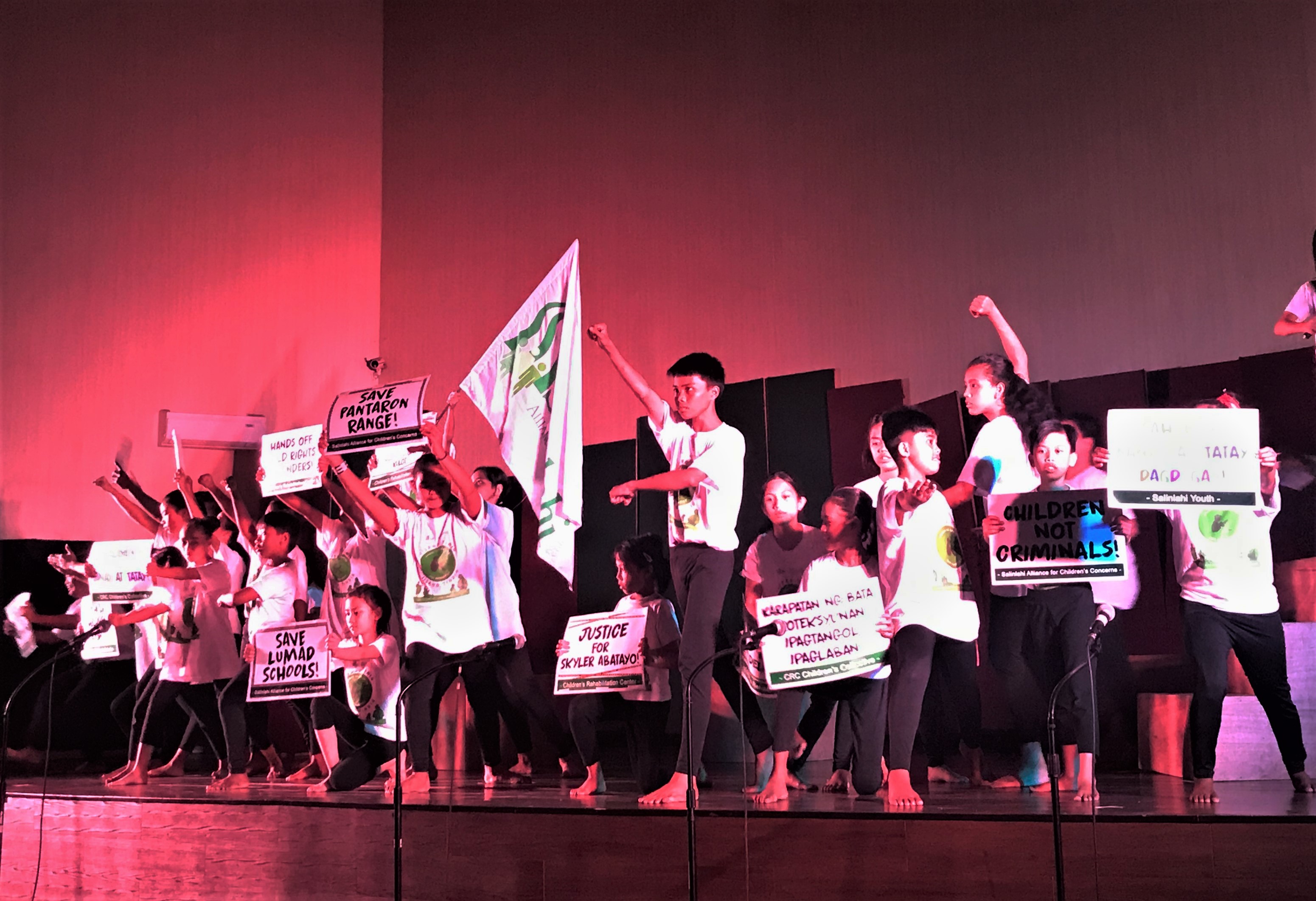Children of ‘3 wars’ share tales of fear, hope on stage

29 children showcased their talents on stage in order to tell their collective story of hope and struggle in the play Iisang Tinig, Iisang Tindig,” produced by the Children’s Rehabilitation Center (CRC)-Children’s Collective.at the University of the Philippines Integrated School Auditorium. Mariejo S. Ramos
MANILA, Philippines — On a rainy December afternoon at the University of the Philippines Integrated School Auditorium, child victims of human rights violations express their anger and sorrow through visual and theater arts—and their voices ring loud and clear.
Irrespective of their origin, skin color and ethnicity, 29 children showcase their talents on stage in order to tell their collective story of hope and struggle in the play “Iisang Tinig, Iisang Tindig”—One Voice, One Stand—produced by the Children’s Rehabilitation Center (CRC)-Children’s Collective.
The 30-minute theater production features children of political prisoners as well as kids who grew up in urban poor and strife-torn communities in Metro Manila and in Mindanao. It is intended to portray the current state of child welfare in the Philippines in the grim context of the “three wars” being waged by the Duterte administration—the war on drugs, war on terror and war against insurgency.
Storytelling
As the play opens, Ayah tries to make the acquaintance of Lina, a new kid on the block. She tells Lina how she lost a friend to a bloody war and how other children were also killed.
Bob, a rural boy who has become a street child, butts in and starts telling them how he and his family came to live in the city.
Article continues after this advertisementAs the three children share their narratives with one another, they realize that their experiences are interrelated and their lives are similar.
Article continues after this advertisement
The child victims of human rights violations expressed their indignation through visual and theater arts–and they made sure their voices were heard loud and clear. Mariejo S. Ramos
Through snappy, thematic segments—song and dance, spoken word and other interpretative acts—the children, some as young as 7 and others in their early teens, are able to sympathize and empathize with each other’s struggles, in the process raising awareness and understanding of the realities faced by Filipino children like themselves.
In one segment of the play, lumad (indigenous) child actors depict how the bombings in their communities have affected their life and education.
They also offer a rendition of the protest song “Ang Bata (Binhi),” singing of children straining to peek out the window and realizing how life has become so tumultuous, so ear-splitting: “Ang bata nakatingala, nakatingkayad sa bintana/Siya’y nakasilip, nakikinig ng gulo sa labas/Bakit ang buhay, kay ingay, kay gulo/Natutulig na ako.”
Peace camp
According to the CRC, some of the child actors—offspring of former political prisoners still fighting charges in court—took part in a peace camp held earlier that day in UP as part of the preparations for the play.
The eldest son of activists Cora Agovida of Gabriela and Michael Bartolome of Kadamay was among the child actors.
On Oct. 31 last year, the family home in Manila was raided by the Philippine National Police’s Criminal Investigation and Detection Group. Agovida and Bartolome were arrested for illegal possession of firearms and explosives, but they maintain that the pieces of evidence were planted.
Other child actors are from Tondo in Manila, Batasan in Quezon City, Olandes in Marikina City, and certain parts of Mindanao.
The peace camp served as a platform for the children to voice their opinions and insights based on their own analysis of their experiences and situation.
Some of the activities led by youth organizations in UP were skit presentations depicting domestic violence against children and art workshops calling for climate action and for the freedom of all political prisoners.
Catharsis
Both the play and the peace camp proved to be cathartic for the children who have had to cope with various forms of abuse, according to the CRC.
The children from Mindanao, for instance, have experienced martial law and the armed conflict in Marawi City in 2017.
“In these cases, children are not spared. A case in point is the murder of Obello Bayao, a 15-year-old student of Salugpongan Lumad School,” said CRC deputy director Nikki Aserios. “Thousands of children are orphaned and have to suffer lifelong consequences and psychological effects such as trauma, mental health problems and behavioral disorder.”
In the war on drugs alone, at least 58 children have been killed by suspected police and vigilante groups, Aserios said.
Interconnectedness
But the play was more than just psychosocial therapy for the children. It also helped them realize that their stories and struggles are interconnected, said the play director, Tiben Wahing of the CRC-Children’s Collective.
It was the children themselves, in fact, who wrote the play based on their own experiences, Wahing said. “Because the children are already aware of the issues that affect them, they were also fully immersed in the production process—from setting the schedules to doing the choreography and lines for the performances.”
Most of them had no prior experience with theater, but the idea of performing on a big stage such as in UP encouraged them to share their talents, Wahing said, adding:
“The play is a compilation of short performances we’ve put up since 2017. Then we held a series of workshops where the children wrote stanzas for the play, and we went through each line to understand its meaning or do some editing. We also have to be sensitive to the children’s trauma and the emotions that they’re willing to express.”
The workshops were held from September to Nov. 23 last year. On Dec. 7, they performed the entire play on stage for the first time.
Some of the issues discussed during the workshops were the impacts of the administration’s “Oplan Tokhang” on poor communities, the bombing of lumad schools and lumad killings, the branding of children as child soldiers, and the lowering of the age of criminal liability.
In turn, the children were able to craft their own narratives and write verses that would express their own understanding of their plight. In that way alone, the play has achieved its objective, Wahing said.
Toward the end of the play, the child actors sing in chorus of the rights of young victims of violence, and of the necessity of debunking the idea that children are entirely powerless: “Kaya naman kahit kami ay bata pa … sinisigaw namin ang mga karapatan ng mga biktima ng karahasan./ Baguhin ang kaisipan na ang bata ay walang magagawa.”